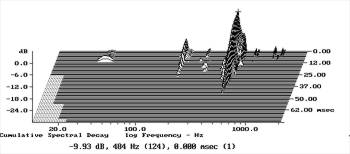| Columns Retired Columns & Blogs |
Meridian Digital Theatre surround-sound music system Measurements DSP6000 part 2
The '6000's step response (fig.21) is hard to interpret, and I admit I was a little surprised not to see the same time-coherent shape as in the '5000. But after I'd inspected the step responses of the individual drive-units, I realized that what fig.21 shows is first the beginning of the midrange unit's positive-going step just after the 8ms mark, over which is then laid the tweeter's negative-going step. The midrange step overshoots after returning to the time axis, its subsequent positive-going recovery coinciding with the positive-going woofer step. This is not a time-coherent design---if that matters. (The jury is still out.)

Fig.21 Meridian DSP6000C, step response on tweeter axis at 50" (5ms time window, 30kHz bandwidth).
Other than a ridge of delayed energy due to the ultrasonic tweeter resonance, the DSP6000's waterfall plot on the tweeter axis (fig.22) is very clean, though with a slight discontinuity at the top of the midrange unit's passband. Despite its large size, the speaker's bass bin is rigidly constructed; on a waterfall plot calculated from the output of an accelerometer fastened to the main panel, only one resonant mode is visible that could have an effect on sound quality: the front. The mode is both sufficiently high in frequency and low enough in level that it should have no effect on the speaker's perceived sound quality.---John Atkinson

Fig.22 Meridian DSP6000C, cumulative spectral-decay plot at 50" (0.15ms risetime

Fig.23 Meridian DSP6000C, cumulative spectral-decay plot of accelerometer output fastened to front panel. (MLS level, -3dBFS; volume control = "70"; measurement bandwidth, 2kHz.)
- Log in or register to post comments




































